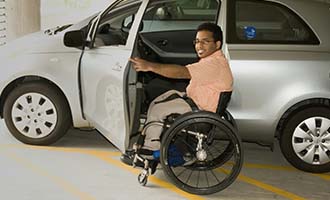Advancements in Treatment and Care for Spina Bifida: What You Need to Know
Explore the latest breakthroughs in the treatment and care for Spina Bifida, and learn how modern solutions are improving the lives of those living with the condition.

Spina Bifida, a congenital condition that affects the spine, has long posed significant challenges for those living with it. However, advancements in medical technology and care have transformed the landscape for individuals with Spina Bifida, providing them with better opportunities to lead active, fulfilling lives. Let’s take a look at the key advancements in treatment and care that are shaping the future for people with this condition.
Fetal Surgery: A Groundbreaking Option
One of the most significant advancements in recent years is fetal surgery, a procedure performed on the fetus while still in the womb. This surgery involves closing the opening in the spine before birth to prevent further damage to the spinal cord and nerves.
Improved Mobility Outcomes
Studies have shown that children who undergo fetal surgery for Spina Bifida have better mobility outcomes compared to those who undergo surgery after birth.
Reduced Risk of Hydrocephalus
The surgery has also been linked to a decreased need for shunt placement to manage hydrocephalus (fluid buildup in the brain), a common complication of Spina Bifida.
While fetal surgery is a complex procedure, it offers hope for better quality of life and long-term health outcomes for children born with Spina Bifida.
Advances in Neurosurgery and Spine Care
Traditional neurosurgical procedures continue to evolve, offering better outcomes for patients with Spina Bifida. Modern neurosurgery techniques have become less invasive and more effective in managing symptoms and complications associated with the condition.
Shunt Systems for Hydrocephalus
Innovations in shunt technology have improved the management of hydrocephalus, reducing the risks of infection and malfunction.
Tethered Cord Surgery
Many individuals with Spina Bifida develop tethered cord syndrome, where the spinal cord is abnormally attached to surrounding tissues. Advances in tethered cord release surgery now provide safer and more effective solutions to alleviate pain and prevent further neurological damage.
These advances ensure that individuals with Spina Bifida can maintain greater mobility and experience fewer complications as they grow older.
Enhanced Mobility Solutions and Assistive Devices
Modern mobility equipment has greatly improved the independence and quality of life for people with Spina Bifida.
Custom Wheelchairs
Advanced wheelchair designs, such as lightweight models with better maneuverability, offer greater comfort and freedom for people with limited mobility.
Exoskeletons
Although still in early stages of development, wearable robotic exoskeletons hold promise for providing mobility assistance, allowing people with Spina Bifida to walk with mechanical support.
These technological advancements make daily tasks easier and give individuals greater autonomy, both at home and in public spaces.
Multidisciplinary Care Approaches
The complexity of Spina Bifida requires a multidisciplinary approach to care, involving a team of specialists such as neurologists, orthopedic surgeons, urologists, and physical therapists. Advances in this model of care have led to better coordination between healthcare providers, ensuring comprehensive treatment for the physical and emotional needs of individuals with Spina Bifida.
Coordinated Care
Patients now benefit from integrated care plans, where all aspects of their health are addressed, from mobility and bladder management to mental health support.
Telemedicine
With the rise of telemedicine, individuals with Spina Bifida have greater access to expert care, even if they live far from specialized healthcare facilities. Telehealth services allow for regular check-ups and consultations without the need for frequent travel.
This holistic approach not only improves medical outcomes but also enhances overall well-being.
Stem Cell Research and Regenerative Medicine
One of the most exciting areas of advancement is stem cell research. Scientists are exploring the potential of stem cells to repair spinal damage caused by Spina Bifida.
Spinal Cord Regeneration
Early studies suggest that stem cell therapy could help regenerate damaged spinal tissues, offering a potential breakthrough in treating Spina Bifida at the cellular level.
Long-Term Potential
While still in experimental stages, stem cell therapies could one day become a routine part of Spina Bifida treatment, improving mobility and reducing complications.
These developments represent a significant step forward in understanding how to repair the nervous system and offer hope for more effective treatments in the future.
Improved Urological and Bowel Management
Many individuals with Spina Bifida face challenges related to bladder and bowel function. Recent advancements in medical devices and treatments are providing better control and comfort.
Bladder Augmentation Surgery
New techniques in bladder augmentation help improve urinary continence and reduce the risk of infection.
Intermittent Catheterization
Innovative catheters and better training have made bladder management easier and more hygienic for individuals with Spina Bifida.
These advancements allow for better management of one of the most common complications of Spina Bifida, improving quality of life and reducing health risks.
Rehabilitation and Physical Therapy
Rehabilitation plays a key role in helping individuals with Spina Bifida maximize their physical abilities. Modern approaches to physical therapy focus on improving mobility, strength, and overall fitness.
Adaptive Physical Therapy
Tailored exercises and therapies help individuals develop strength, balance, and flexibility, even with limited mobility.
Assistive Technology in Therapy
Devices like robotic-assisted gait trainers and virtual reality systems are being integrated into rehabilitation programs to enhance therapeutic outcomes.
By continuing physical therapy, people with Spina Bifida can maintain their independence and improve their functional abilities over time.
Advancements in treatment and care for Spina Bifida have opened new doors for those living with the condition. From fetal surgery and mobility aids to stem cell research and coordinated care, these developments are helping individuals with Spina Bifida lead healthier, more independent lives. With ongoing research and innovation, the future looks bright for improving the quality of life for people with Spina Bifida.
Related
-

The benefits of elder care services
-

How to keep going with limited mobility
-

Folding vs Non-Folding Electric Wheelchairs: Which One Should You Buy
-

Top 3 Types of Wheelchairs with Built-In Toilet Seats: Enhancing Dignity and Convenience
-

Breaking Barriers: Why Urban Spaces Must Be More Wheelchair-Friendly
-

Tips to Select the Best Caretaker Services in Mumbai
-

Smart Tips to Buy a Folding Electric Wheelchair Online
-

The Pros and Cons of Buying an Electric Wheelchair Online
-

Cost of Caretaker Services in Mumbai: What to Expect in 2025?
-

How to Choose Reliable Elder Care Assistance Providers
-

Different Types of Home Health Care Services in India
-

The Ultimate Guide to Wheelchair Accessories: Boost Your Independence Today
-

Dont stop moving!
-

A Complete Guide to Wheelchair Types and Their Prices in India
-

Best Online Stores to Buy Disability Equipment in Mumbai
-

Elderly Care Services Offered by Modern Health Providers
-

Apps make caregiving easier
-

Senior care top tips
-

Tech that makes life better
-

Best Physical Therapists in Mumbai For Home Treatment
-

Enhancing Quality of Life
-

The Essential Guide to Finding the Best Patient Care Taker in Mumbai
-

Choose your wheelchair well
-

Dealing with the odds
-

Celebrating Carers Week : The Unsung Heroes Behind Every Confident Step
-

Top Emergency Apps Every Disabled Person Should Have
-

What Makes a Great Support Companion? A Peek Into MobiCrews Training and Ethos
-

Caregiver Services for Post-Surgery Recovery in Mumbai
-

Top 10 Electric Wheelchairs to Buy Online in India: 2025 Edition
-

Tips for Choosing the Right Health Service Provider
-

How to Choose the Right Caretaker Agency in Mumbai
-

Apps that keep you healthy
-

How Assistive Technology is Transforming Mobility Independence
-

Who make for ideal caregivers?
-

Navigating Mumbai with Ease: Your Guide to Reliable Mobility and Elder Care Solutions
-

Step into healthy living
-

Mobility aids to the rescue
-

Apps that simplify life
-

Tips to Find the Best Healthcare Provider Partners in Mumbai
-

What is a Health Care Service Provider?
-

A Guide to Choosing the Right Handicapped Equipment for Your Needs
-

Rehab: The road to recovery
-

Smart Home Care Equipment for Seniors That Make Life Easier
-

A Guide to Buy Mobility Equipment Online
-

Detailed Guide On Best Elder Care Services in Mumbai
-

What do companion caregivers do?
-

Insurance is key to inclusion
-

A Comprehensive Guide to Buying Mobility Products for Seniors in India
-

Elder Care Services in Mumbai: Comparing In-Home Care vs. Assisted Living Option
-

How to Choose the Right Health Service Provider for Your Needs
-

The benefits of community care
-

Adapt your vehicle
-

Tips for Buying the Best Mobility Equipment for Your Needs
-

How to Choose the Right Mobility Chair for Seniors in Mumbai









